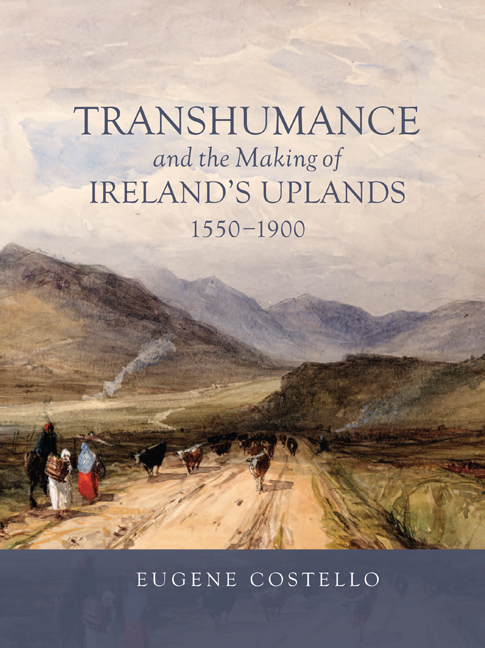Book contents
- Frontmatter
- Contents
- List of Illustrations
- Preface and Acknowledgements
- Note on Chronology
- Introduction
- Chapter 1 Seasonal Movement and Settlement in A World of Pastoralism
- Chapter 2 Imagining Movement: Past and Present Views of Transhumance in Ireland
- Chapter 3 Seasonal Sites in Context: Summer Pastures of the Carna Peninsula
- Chapter 4 Connected Places: Home and Booley in Gleann Cholm Cille Over Time
- Chapter 5 Altitude and Adaptation: Evolving Seasonal Settlement in the Galtee Mountains
- Chapter 6 Herders and Historical Forces, 1600–1900
- Conclusion
- Bibliography
- Index
Chapter 4 - Connected Places: Home and Booley in Gleann Cholm Cille Over Time
Published online by Cambridge University Press: 01 October 2020
- Frontmatter
- Contents
- List of Illustrations
- Preface and Acknowledgements
- Note on Chronology
- Introduction
- Chapter 1 Seasonal Movement and Settlement in A World of Pastoralism
- Chapter 2 Imagining Movement: Past and Present Views of Transhumance in Ireland
- Chapter 3 Seasonal Sites in Context: Summer Pastures of the Carna Peninsula
- Chapter 4 Connected Places: Home and Booley in Gleann Cholm Cille Over Time
- Chapter 5 Altitude and Adaptation: Evolving Seasonal Settlement in the Galtee Mountains
- Chapter 6 Herders and Historical Forces, 1600–1900
- Conclusion
- Bibliography
- Index
Summary
This book's second case study centres on the civil and Roman Catholic parish of Gleann Cholm Cille in south-west Donegal (Figure 4.1). It lies at the end of the Slieve League (Sliabh Liag) peninsula – Sliabh Liag being the highest point in the parish and peninsula at 595m a.s.l. Gleann Cholm Cille forms part of the Donegal Gaeltacht and its name translates into English as ‘The Valley of Colmcille’, Colmcille being a sixth-century Irish saint with whom an early medieval ecclesiastical site in the parish is associated. Like the rest of the peninsula, the landscape of Gleann Cholm Cille is essentially hilly. Three valleys running eastwards from the Atlantic coast cut the parish into approximately four upland blocs of varying extent, but all being 200m or greater in altitude. On the east the parish is bounded by the Abhainn Ghlinne (or ‘Glen River’), which has its source in the north and its mouth at Teileann Bay in the south. At its maximum it measures 12km from east to west and 18km from north to south, and covers an area of approximately 132km2.
There are two main types of bedrock in the area – psammitic and pelitic schist, marble, amphibolite and diamictite in most of the centre and along Abhainn Ghlinne, and quartzite on higher ground in the north and parts of the south. Blanket peat dominates the subsoil and soil layers of most of the parish, especially on the higher upland blocs. However, significant quantities of peaty podzols can be found on the lower slopes, along with acid brown earths and surface water gleys in the valleys, all of which have substantially greater agricultural potential than peat (GSI Datasets Public Viewer). Blackface mountain sheep predominate in the uplands, with small numbers of dry cattle found on improved farms in the valleys. Tree cover is very sparse today in the area, occurring only occasionally along field boundaries and roads. In some remote upland townlands, however, woodland scrub is beginning to regenerate as farming enters a stage of abandonment. Modern settlement is found in four main locations: Gleann village in the central valley of the parish (where most services are located), Málainn Mhór south of that, Málainn Bhig in the extreme south-west, and along Abhainn Ghlinne from the village of An Charraig northwards to Mín an Chearrbhaigh.
- Type
- Chapter
- Information
- Transhumance and the Making of Ireland's Uplands, 1550–1900 , pp. 82 - 106Publisher: Boydell & BrewerPrint publication year: 2020



